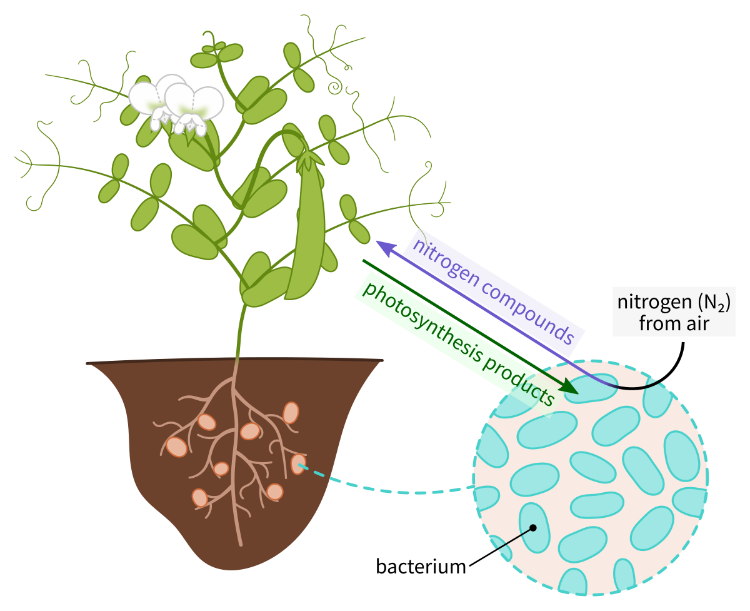To Inoculate Or Not To Inoculate - That Is The Question
Many Manitoba farms love soybeans and peas as a rotational crop because of their low input needs thanks to their ability to source their own nitrogen fertilizer through a symbiotic relationship with a specific rhizobia bacterium in the soil. The bacteria provide the legume plants with nitrogen (that they have converted from non-greenhouse N-gases in the air) in exchange for carbon and other photosynthetic products that the bacteria need for food.
One of the inputs that is used on legume crops is inoculant, which ensures the establishment of the relationship rhizobia provides nitrogen for the plant.
More and more frequently, I am asked the following questions: Is inoculating necessary at all? Are we actually seeing yield benefit? When should I inoculate? There is a range of opinions for these questions - some will say they don’t tend to see benefits; some say there are significant benefits, others say “it’s cheap insurance”. Whichever way you choose, it is important to consider the consequences you may face if you do not inoculate and have a failure of the relationship between bacteria and plant.
Dr. Barney Geddes from the Department of Microbiological Sciences at NDSU presented at the MAC 2023 to discuss his lab’s research that is working on a sampling technology to test and quantify soil biology (similar to a soil test). And their lab is posing the question of Effective vs Competitive Rhizobium. The link to this presentation is attached below.
To summarize some of the main points of Dr. Geddes presentation and findings that are applicable on your farm:
- In perfect conditions, rhizobia bacteria can persist in soil for up to 5 years. However, challenging soil/environmental conditions such as flooding and drought, acidic pH, salinity, etc. can cause significant mortality in rhizobia populations. This is why the recommendation traditionally has been to apply at least a single rate inoculant every year.
- The lab has found that natural strains of rhizobium in soil that are most prevalent and in highest populations are most often poor quality but will also tend to be most competitive for forming nodules on plants, therefore we do not see them driving nitrogen into the plant effectively and feeding yield. Dr. Geddes states that we don’t see the same benefit from these nodules as compared to the rhizobium in inoculant that has been developed for high performance. He suggests the reasoning is the less effective natural rhizobium are highly adapted to the local soil conditions and have a better ability to outcompete the inoculant bacteria.
- Through heavy sampling and research, Geddes’s lab found there are few natural strains that proved to be both competitive in the soil and highly effective at providing nitrogen. These are the strains that are important to encourage and are what the industry will try to mimic when developing inoculants.
So, what are the steps moving forward?
1. Farm-scale sampling to quantify soil biology within fields and identify the strains of rhizobia present.
2. Learn ways to nourish these effective and competitive strains in the soil so that we won’t need to rely on purchasing competitive inoculants to ensure the success of our pulse crops.
https://www.youtube.com/watch=DM8ejAzMlnU&list=PLaNpczapd8GGscGj6SvtSB_y6WuZjmoFB&index=14
Inoculation practices:
- MPSG recommendations
- Dr. Barney Geddes @ NDSU, Department of Microbiological Sciences, Geddes Lab.
o “Biological potential to meet crop nutrient demands”.
o Studying microbiology to deliver nutrients to crops and assist with crop demands.
o “legumes are pillars of sustainable agriculture” because they can source/fix their own nitrogen and also reduces run-off of fertilizers or gassing-off – goes directly to the plant.
o Show photo of symbiotic nitrogen fixation.
o Asked 2 questions: When should farmers inoculate? How can we maximize the benefit from inoculation and when do we see reults?
o Not cross-compatible rhizobia for each crop. Unique relationship with bacteria and crop. Ex: Soybeans-Brady rhizobium, Peas-Rhizobium.
o Granular/Peat/Liquid comparissons.
o Different opinions to inoculating – Some don’t tend to see benefits, some say cheap insurance – consequence of not putting it on and not having that relationship with the bacteria can be detrimental., some say yes wonderful benefit
o Inoculation history makes a difference
o Carrington REC research suggests not necessary for 5 years after first planting soybeans
- Soybean Field Production Guide for North Dakota
- Challenging soil conditions that are variables
· Drought/Flooding will significantly deplete rhizobia populations
· Acidic pH
· Salinity
· IDC can disrupt the relationship
· High residual N – plants are quicker to accept this free nitrogen.
o Hoping to see testing for soil biology that can quantify rhizobia and other soil biology in the fields.
- Ability to do this on small scales currently. Quantifies the DNA of the rhizobia and estimates numbers in the sample. Trying to expand their detection limit.
o This sampling technology has brought some indications that can help agronomists with their recommendations
- Potentially lower inoculant persistence in Western ND with more arid soils.
- Advice from Carington does not hold true – survivability seems to do with soil moisture.
o If there is residual rhizobia present, do we see a benefit from adding an inoculant?
- Residual rhizobia is often the case with peas.
- Their results from areas with both high and low residual rhizobia – peas, even when rhizobia levels were low, the did not see and increase in nodulation coming from the inoculant. Chickpeas did show a response.
- Do we see a yield response to inoculation – yes with chickpeas. Not seeing it in peas.
o Rhizobia competition
- Effective vs. Competitive rhizobium.
- Research has suggested that native rhizobium are less adapted as efficient nitrogen fixers. When they form the nodules, we don’t see the same benefit as compared to the rhizobium developed for high performance.
- Just because there is a nodule present does not mean it’s doing the most optimal job at delivering nitrogen.
- Natural rhizobium in soil (less effective) locally adapted to survive in those soils and will outcompete the inoculant rhizobium.
- Research hasn’t confirmed whether or not the natural rhizobium are beneficial/efficient or not. If they are or there are ways you can nourish those populations, then you don’t need to inoculate.
- But if they are not beneficial, when they form the nodules we don’t see the symbiosis benefit of increased yield and adding residual n to the soils.
- Need to make sure the inoculants we apply are very competitive.
- What is the quality of the natural rhizobia?
· Huge variation found in their research in 2020. The bigger the pea and more vigorous can be an indication of a more effective rhizobia.
· Which are the strains that are most competitive and tend to for the nodules. Ability to use molecular bar-codes on the rhizobia to get a measurement of the effectiveness.
· Saw that some strains are very competitive across many different soil conditions.
· Biggest concern they found in their research was that the poor quality rhizobia (which tend to be more prevalent/higher populations) also tend to be more competitive.
· Natural rhizobium are tending to not be very good quality therefore not provide good yield boosting benefits to the plant.
· Encouraging because there are some strains that have both high quality and competitiveness – use these strains to develop inoculants.
- Highly competitive inoculants may be requires to outcompete the inferior native strains.
~Katie Meggison

